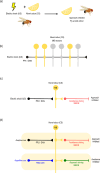What could evolve in the evolution of memory?
- PMID: 40566906
- PMCID: PMC12198905
- DOI: 10.1098/rstb.2024.0109
What could evolve in the evolution of memory?
Abstract
Over the past five decades, advances in neuroscience have set out the adaptive landscape of memory, illuminating semi-independent storage mechanisms, forgetting mechanisms and modifications to basic machinery that bring context specificity. Yet because much of neuroscience aims to understand how the human brain functions, rather than to explore taxonomic diversity, the implications for animal cognitive evolution remain underexplored. This perspective article examines the potential evolutionary diversity of animal memory from a mechanistic viewpoint. We argue that taking into account neurogenetic and neurophysiological mechanisms of memory could illuminate how the diversity of cognitive traits has been shaped by natural selection. By focussing on memory in insects, notably through the lens of associative processes, we target our discussion on potential variation in taxonomically general processes within one of the animal kingdom's richest and most diverse animal groups. This exploration aims to broaden the discourse on memory evolution within the field of cognitive ecology towards an understanding of the many ways in which memory could be shaped by natural selection.This article is part of the Theo Murphy meeting issue 'Selection shapes diverse animal minds'.
Keywords: behaviour; cognition; evolution; memory.
Conflict of interest statement
We declare we have no competing interests.
Figures


Similar articles
-
Evolution of diverse (and advanced) cognitive abilities through adaptive fine-tuning of learning and chunking mechanisms.Philos Trans R Soc Lond B Biol Sci. 2025 Jun 26;380(1929):20240117. doi: 10.1098/rstb.2024.0117. Epub 2025 Jun 26. Philos Trans R Soc Lond B Biol Sci. 2025. PMID: 40566910 Free PMC article.
-
Short-Term Memory Impairment.2024 Jun 8. In: StatPearls [Internet]. Treasure Island (FL): StatPearls Publishing; 2025 Jan–. 2024 Jun 8. In: StatPearls [Internet]. Treasure Island (FL): StatPearls Publishing; 2025 Jan–. PMID: 31424720 Free Books & Documents.
-
The Lived Experience of Autistic Adults in Employment: A Systematic Search and Synthesis.Autism Adulthood. 2024 Dec 2;6(4):495-509. doi: 10.1089/aut.2022.0114. eCollection 2024 Dec. Autism Adulthood. 2024. PMID: 40018061 Review.
-
"In a State of Flow": A Qualitative Examination of Autistic Adults' Phenomenological Experiences of Task Immersion.Autism Adulthood. 2024 Sep 16;6(3):362-373. doi: 10.1089/aut.2023.0032. eCollection 2024 Sep. Autism Adulthood. 2024. PMID: 39371355
-
How does cognition determine an individual's fitness? A systematic review of the links between cognition, behaviour and fitness in non-human animals.Philos Trans R Soc Lond B Biol Sci. 2025 Jun 26;380(1929):20240118. doi: 10.1098/rstb.2024.0118. Epub 2025 Jun 26. Philos Trans R Soc Lond B Biol Sci. 2025. PMID: 40566909 Free PMC article.
Cited by
-
Linking individual fitness to the evolution of cognition.Philos Trans R Soc Lond B Biol Sci. 2025 Jun 26;380(1929):20240122. doi: 10.1098/rstb.2024.0122. Epub 2025 Jun 26. Philos Trans R Soc Lond B Biol Sci. 2025. PMID: 40566913 Review.
-
Evolution of diverse (and advanced) cognitive abilities through adaptive fine-tuning of learning and chunking mechanisms.Philos Trans R Soc Lond B Biol Sci. 2025 Jun 26;380(1929):20240117. doi: 10.1098/rstb.2024.0117. Epub 2025 Jun 26. Philos Trans R Soc Lond B Biol Sci. 2025. PMID: 40566910 Free PMC article.
-
Selection shapes diverse animal minds.Philos Trans R Soc Lond B Biol Sci. 2025 Jun 26;380(1929):20240108. doi: 10.1098/rstb.2024.0108. Epub 2025 Jun 26. Philos Trans R Soc Lond B Biol Sci. 2025. PMID: 40566907 Free PMC article.
-
Modality-specific long-term memory enhancement in Heliconius butterflies.Philos Trans R Soc Lond B Biol Sci. 2025 Jun 26;380(1929):20240119. doi: 10.1098/rstb.2024.0119. Epub 2025 Jun 26. Philos Trans R Soc Lond B Biol Sci. 2025. PMID: 40566908 Free PMC article.
References
-
- Dukas R. 2004. Evolutionary biology of animal cognition. Annu. Rev. Ecol. Evol. Syst. 35, 347–374. ( 10.1146/annurev.ecolsys.35.112202.130152) - DOI
-
- Abramson CI. 1994. A primer of invertebrate learning: the behavioural perspective. Washington, DC: American Psychological Association.
MeSH terms
LinkOut - more resources
Full Text Sources
Medical
Miscellaneous

